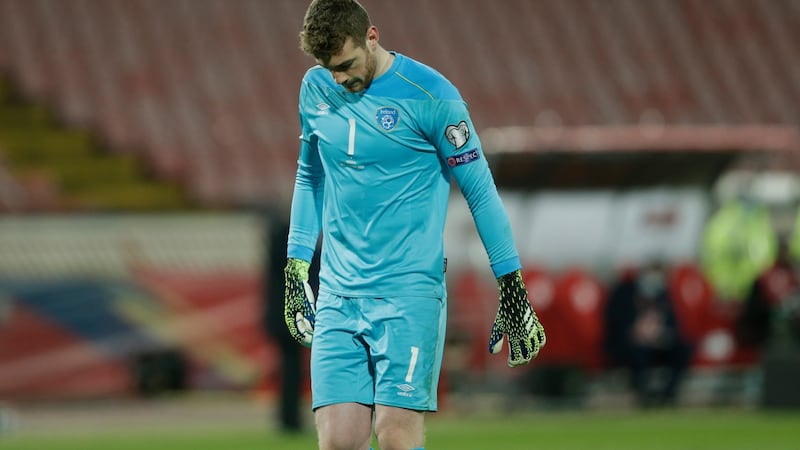The great advantage of your team not winning any competitive games for two years is that you learn to appreciate the little things.
Like a prisoner chained in a deep dark dungeon, who licks hungrily at the beads of dew forming on the walls and weeps with gratitude as he wolfs down centipedes and woodlice, you nod admiringly at competent pieces of control and send excited text messages about interesting five-pass moves.
When a move of the quality of the one that led to Alan Browne’s goal materialises it lights up your world as though a thousand suns had exploded all at once.
How old do you have to be to remember the last time Ireland put together a move like that? The key moment was the instant outside of the foot crossfield pass from Browne that unbalanced the Serbian defence, but there was so much to admire about a strike that involved contributions from half the team.
This was what we came to see. Here were the principles that Stephen Kenny talked about when he came into the job: pressing, passing, movement, combination play.
For the first half hour of the game, as Ireland passed and pressed and seemed in control, it was as though the prisoner had squeezed through a burrow and was slithering through the sewers towards the dim light of freedom.
Now Ireland just need to figure out how to be able to sustain this kind of effort for 90 minutes. Even towards the end of the first half there were hints that Ireland were tiring, the pressing had dropped off, the defence had dropped back.
After 61 minutes Jayson Molumby was replaced by Jeff Hendrick; it was unclear whether Molumby's slow-walk off the pitch was gamesmanship or just exhaustion; Kenny later confirmed he was "just running out of steam".
By 65 minutes, Aaron Connolly, who celebrated his 21st birthday two months ago, was sitting on the ground apparently suffering from cramp. That signalled the end of his involvement.
Molumby and Connolly are two of the players Kenny has pinned a lot of his hopes on, but they’ll need to get a lot fitter than this, which means playing regular club football as soon as possible.

With everything going well it felt natural that a Serbian goal arrived as a sudden sucker punch, the prisoner tentatively poking his head out of the manhole only to be smashed by the mailed fist of the waiting jailer.
Dusan Vlahovic's goal came from the kind of simple move that is hard to stop if executed well: a quick clip to Dusan Tadic, lurking in his usual pocket between the Irish lines, the Serbia captain sent a superb deep header beyond Dara O'Shea for Vlahovic to chase.
Tadic's header was so quick that Mark Travers, who had looked a little nervous on the ball in the early passing exchanges, had only a fraction of a second to make up his mind what to do: should he charge the attacker or should he hold his ground? He looked like he might rush forward, then hesitated and stepped back and to his right; Vlahovic kept his composure under pressure from O'Shea to slot the ball to Travers's left and inside the far post.
Was this moment playing on Travers’s mind when the pivotal moment of the game arrived on 69 minutes? Was he thinking: ‘I should have been more proactive, next time I’m not going to be passive and retreat?’
The fatal move was again simple: just after Connolly had been replaced by Shane Long, Travers took a goal kick, the Serb defence beat Long to the header, the ball dropped behind Ireland's midfield where there were three Serbs and no Irish players.
Vlahovic found Tadic who played it to Mitrovic, who looked up and saw that Travers had, for some reason, advanced to the edge of his box.
It seemed as though he had been seized with the impulse to play sweeper-keeper but he was nowhere near the ball and it was immediately obvious he was in trouble.
Mitrovic must have been surprised but kept his cool to send an easy chip over the head of the hopelessly stranded Travers. The execution was efficient but the chance was simple: this was an awful mistake by the young goalkeeper.
Serbia quickly added a third, Tadic escaping the attentions of the Irish midfielders and, this time under no pressure, finding the head of Mitrovic, who easily dominated Clark in the air and beat Travers with a header. He barely had to jump and looked a bit like an adult playing against kids, which was largely thanks to the quality of the ball from Tadic.
Shane Duffy won't have been the only one who noticed that two of the three Serbian goals had involved his direct replacement losing a header.
There was late hope as Long and Collins chased down and punished more clumsy Serbian defending, but Ireland ran out of time to equalise. Another defeat, with mitigating circumstances, depending on how patient you’re disposed to be.
Ireland gave their best performance for a long time, but ultimately a young third-choice goalkeeper struggled on his competitive debut, a penalty that could have been awarded to Connolly wasn’t, and Serbia got the points.
Ireland lost another match but at least they found a way of playing: the 3-5-2 looks to have more potential than the lifeless systems tried thus far. In the context of where this team and its supporters have been, that is, at the very least, an above-averagely-tasty centipede.












